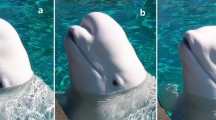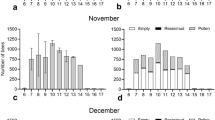Abstract
The ability of cotton-top tamarins to discriminate between scents from conspecifics and those from other tamarin species, and between scents from conspecific individuals was tested. Cotton-tops scent mark with specialized skin glands in the circumgenital area. Females possess larger glands than males and show more scent-marking behavior. In the first experiment, subjects were presented with a glass rod scented with either material collected from the surface of the scent glands of a conspecific female, with scent material from a female of a related species, or with an unscented rod. Glass rods carrying scent from conspecifics were sniffed more frequently than rods carrying scent from related tamarin species or unscented rods. A second experiment offered a choice between two glass rods, one scent marked by aSaguinus o. oedipus female, the second one scent marked by aSaguinus fusdcollis female. Shelves carrying rods that had been scent marked by conspecifics were contacted more frequently than those carrying rods marked by heterospecific females. Scent marks from conspecific females were also sniffed more frequently. A third experiment compared the level of responses to rods carrying material collected from the scent glands of female individuals to which the subjects had been habituated with their responses to rods carrying scent from females to which they had not been habituated. Contacting and sniffing responses to the scents of novel females were higher than those to the scents of females to which the subjects had been habituated.
Similar content being viewed by others
References
Belcher, A.M., Smith, A.B., Ill, Jurs, P.C., Lavine, B., andEpple, G. 1986. Analysis of chemical signals in a primate species (Saguinus fuscicollis): Use of behavioral, chemical and pattern recognition methods.J. Chem. Ecol. 12:513.
Epple, G. 1974. Pheromones in primate reproduction and social behavior, pp. 131–155,in W. Montagna and W.A. Sadler (eds). Reproductive Behavior. Plenum Press, New York.
Epple, G. 1986. Communication by chemical signals, pp. 531–580,in G. Mitchell (ed.). Comparative Primate Biology, Vol. II, Behavior, Conservation and Ecology. Alan R. Liss, New York.
Epple, G., Golob, N.F., andSmith, A.B., III. 1979. Odor communication in the tamarinSaguinus fuscicollis. Behavioral and chemical studies, pp. 117–130,in F.J. Ritter (ed.). Chemical Ecology: Odour Communication in Animals. Elsevier/North Holland, New York.
Epple, G., Belcher, A.M., andSmith, A.B., III. 1986. Chemical signals in callitrichid monkeys — a comparative review, pp. 653–672,in D. Duvall, D. Müller-Schwarze, and R. M. Silverstein (eds.). Chemical Signals in Vertebrates, Vol. 4, Ecology, Evolution and Comparative Biology, Plenum Press, New York.
French, J.A., andCleveland, J. 1984. Scent marking in the tamarin,Saguinus oedipus: Sex differences and ontogeny.Animal. Behav. 32:615.
French, J.A., andSnowdon, C.T. 1981. Sexual dimorphism in intergroup spacing behavior in the tamarin,Saguinus o.oedipus. Anim. Behav. 29:822.
French, J.A., Abbott, D.H., andSnowdon, C.T. 1984. The effect of social environment on estrogen excretion, scent marking and socio-sexual behavior in tamarins (Saguinus o. oedipus).Am. J. Primatol. 6:155.
Hershkovitz, P. 1977. Living New World Monkeys (Platyrrhini), Vol. I. The University of Chicago Press, Chicago.
Moynihan, M. 1970. Some behavior patterns of platyrrhine monkeys II.Saguinus geoffroyi and some other tamarins.Smithson. Contrib. Zool. 28:1.
Perkins, E.M. 1966. The skin of the black-collared tamarin (Tamarinus nigricollis.Am. J. Phys. Anthropol. 25:41.
Perkins, E.M. 1969. The skin of the cotton-top pincheSaguinus (= oedipomidas) oedipus.Am. J. Phys. Anthropol. 30:13.
Schilling, A. 1979. Olfactory communication in prosimians, pp. 461–542,in G.A. Doyle and R.D. Martin (eds.). The Study of Prosimian Behavior. Academic Press, New York.
Smith, A.B., III, Belcher, A.M., Epple, G., Jurs, P.C., andLavine, B. 1985. Computerized pattern recognition: A new technique for the analysis of chemical communication.Science 228:175.
Wolters, H.J. 1978. Some aspects of role taking behaviour in captive family groups of the cotton-top tamarin,Saguinus oedipus oedipus, pp. 259–278,in H. Rothe, H.J. Wolters, and J.P. Hearn (eds.). Biology and Behaviour of Marmosets. Eigenverlag H. Rothe, Göttingen.
Author information
Authors and Affiliations
Rights and permissions
About this article
Cite this article
Epple, G., Küderling, I. & Belcher, A. Some communicatory functions of scent marking in the cotton-top tamarin (Saguinus oedipus oedipus). J Chem Ecol 14, 503–515 (1988). https://doi.org/10.1007/BF01013902
Received:
Accepted:
Issue Date:
DOI: https://doi.org/10.1007/BF01013902




